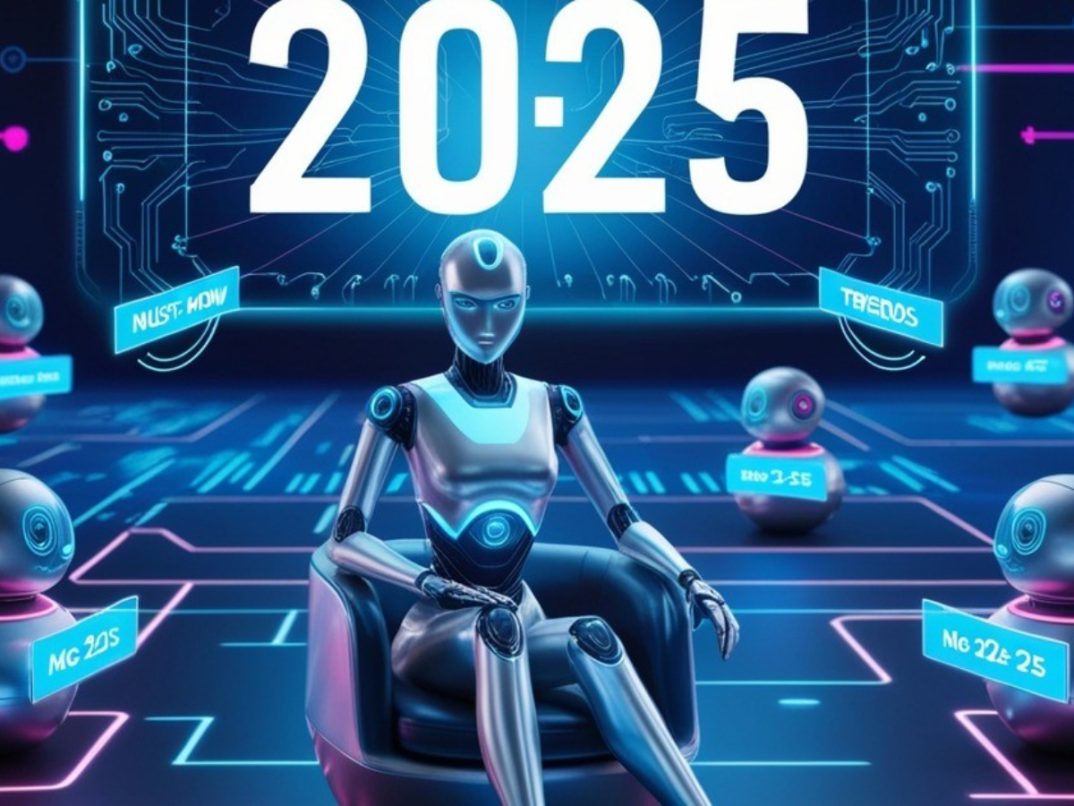The marketing world is on the brink of another transformative year as AI continues to evolve and reshape the field. Following its unprecedented adoption in 2024, strong AI is poised to drive even greater innovation in 2025. Businesses that adapt quickly to these developments will unlock new opportunities to connect with audiences, optimize strategies, and stay ahead of the competition.
Here’s a look at the most anticipated AI marketing developments for 2025, including trends from 2024 that will expand and new emerging innovations.
Building on 2024 Trends
AI set the stage in 2024 with groundbreaking advancements in hyper-personalization, predictive analytics, and generative AI tools. These trends are only set to grow:
1. Hyper-Personalization Evolves Further
The ability of AI to craft individualized experiences will expand in 2025. Marketers will use real-time data and predictive algorithms to engage audiences across multiple channels seamlessly.
Source: AI Marketing – Trends and Predictions
2. Predictive Analytics Gains Mainstream Adoption
In 2024, predictive analytics became a powerful tool for anticipating customer behavior. In 2025, businesses will rely on it to fine-tune campaigns with unprecedented accuracy.
Source: AI in Marketing – Trends and Predictions
Read Also : 8 Tips for Boosting Marketing Efficiency with Automation Tools
3. Generative AI Becomes a Marketing Standard
AI tools for content creation, like ChatGPT and DALL·E, became indispensable in 2024. In 2025, these technologies will become standard marketing tools, allowing businesses to scale creative output while maintaining quality.
New Innovations to Watch in 2025
1. AI-Driven Consumer Psychology
One of the most exciting advancements in AI for 2025 is its integration with consumer psychology. This emerging trend goes beyond predicting customer behavior—it actively influences it by leveraging psychological insights and behavioral data. By combining the power of AI with principles of human psychology, businesses can create marketing strategies that connect with audiences on a deeper, more emotional level.
Understanding Consumer Behavior at Scale: AI excels at analyzing vast amounts of data, from browsing patterns and purchase history to social media interactions. In 2025, businesses will use these insights to uncover what motivates their audiences and tailor campaigns that align with their needs and preferences.
Emotionally Intelligent Campaigns
AI systems equipped with sentiment analysis will allow marketers to gauge emotional states in real time. Whether through analyzing tone in text, voice patterns, or visual cues, businesses can craft content that resonates emotionally—whether to build trust, spark excitement, or create urgency.
Personalized Psychological Triggers
Marketers will deploy AI to incorporate cognitive triggers into their campaigns, such as:
Social Proof: Highlighting how others are using or benefiting from a product.
Scarcity: Creating urgency by emphasizing limited availability.
Reward Anticipation: Offering incentives like discounts or loyalty points to tap into consumers’ reward systems.
These triggers will be customized at an individual level, amplifying their effectiveness.
Read Also : How to Choose Between Fixed and Variable Mortgages Based on Your Financial Goals
Adaptive User Experiences
Another key innovation in 2025 will be AI’s ability to adjust marketing efforts in real time. For instance, if a consumer lingers on a checkout page, the system might automatically present a special offer to reduce hesitation. Such tactics, rooted in psychological principles like loss aversion or reciprocity, will improve conversion rates and customer satisfaction.
Predicting and Influencing Behavior
AI-driven consumer psychology will allow brands to move from reactive to proactive strategies. By forecasting behavior—such as identifying customers likely to churn—businesses can implement personalized interventions. For example, a timely email emphasizing the unique value a customer hasn’t yet experienced can rekindle their interest.
Why It Matters for 2025
As digital competition intensifies, connecting with consumers on a human level will be critical for success. AI-driven consumer psychology combines the best of technology and behavioral science, empowering businesses to build trust, foster loyalty, and enhance campaign performance. This trend is expected to become a cornerstone of marketing strategies as AI tools continue to evolve.
2. Autonomous Marketing Campaigns
Imagine marketing campaigns that plan, execute, optimize, and even conclude themselves without human intervention. In 2025, this vision is becoming a reality as autonomous marketing campaigns emerge as a major trend. Leveraging advanced AI systems, businesses will be able to automate the entire lifecycle of their marketing efforts, allowing teams to focus on high-level strategy and creative innovation.
From Automation to Autonomy
While marketing automation tools are already mainstream, 2025 will see the evolution to full autonomy. These systems won’t just schedule posts or send emails; they’ll analyze performance data, adjust targeting, allocate budgets, and even create new campaign assets based on real-time feedback—all without human input.
Self-Optimizing Campaigns
Autonomous systems will use machine learning to continuously improve campaign performance. For example, an AI-driven campaign could analyze click-through rates on ads, identify underperforming creatives, and replace them with new variations it generates—all while reallocating spend to the most effective channels.
Hyper-Personalized Execution
These campaigns will excel at delivering hyper-personalized content at scale. By analyzing individual consumer behaviors, preferences, and purchase histories, autonomous systems can deliver tailored messages to each customer, whether it’s through email, social media, or direct website interactions.
Real-Time Adaptation
Unlike traditional campaigns that require manual updates, autonomous marketing campaigns will adapt in real time. For instance, if a product sells out, the system can immediately pivot to promoting complementary items or suggest pre-order options to customers interested in restocking.
Freeing Up Human Creativity
The rise of autonomous campaigns doesn’t mean marketers will become obsolete. Instead, these systems will handle repetitive, data-heavy tasks, allowing human teams to focus on storytelling, strategic planning, and creating brand value. This shift will redefine roles within marketing departments, emphasizing creativity and innovation over execution.
Why It Matters for 2025
As businesses face growing complexity in managing multi-channel campaigns, autonomous systems will offer a solution to improve efficiency and scalability. By combining automation, AI, and real-time decision-making, these campaigns will not only save time but also significantly enhance ROI. Marketers who embrace this trend will have a clear competitive edge, using AI to drive smarter, more effective campaigns.
3. Voice and Visual AI for Customer Engagement
As consumers demand more immersive and interactive experiences, voice and visual AI are set to become pivotal tools for customer engagement in 2025. These technologies will enable brands to connect with their audiences in dynamic and personalized ways, creating richer interactions that stand out in a crowded digital landscape.
The Rise of Voice AI in Marketing
Voice AI, already popularized through virtual assistants like Siri and Alexa, will take on a broader role in customer engagement. In 2025, businesses will integrate voice AI into their strategies to create seamless, conversational interactions. From answering customer queries to guiding users through purchasing decisions, voice-enabled marketing will become an essential tool for improving accessibility and user experience.
• Virtual Brand Assistants: Brands will deploy their own AI-driven voice assistants to provide on-demand information, troubleshoot issues, or recommend products, enhancing customer service efficiency.
• Interactive Ads: Voice-enabled ads will allow users to respond verbally, creating a two-way conversation that drives deeper engagement.
Visual AI for Personalized Interactions
Visual AI will revolutionize how customers interact with content. By analyzing visual data, such as customer-uploaded photos or live video feeds, AI can offer highly customized experiences:
• Virtual Try-Ons: Fashion, beauty, and home décor brands will use visual AI to let customers “try on” products or preview how items will look in their environment.
• Interactive Visual Content: AI-generated images and videos will be tailored to individual preferences, making every interaction feel unique and personal.
• Enhanced Visual Search: Consumers will use images to search for products, and visual AI will identify items or offer similar recommendations instantly.
Combining Voice and Visual AI
In 2025, the most innovative brands will combine these technologies to create holistic, multi-sensory experiences. For example, a customer browsing a clothing website could use voice AI to ask for outfit suggestions while visual AI displays personalized options in real time.
Breaking Down Language and Accessibility Barriers
Voice and visual AI will also make marketing more inclusive. Multilingual voice assistants and visually interactive content will bridge gaps for customers with language or accessibility challenges, broadening brand reach and improving user satisfaction.
Voice and visual AI will set new standards for customer engagement, allowing brands to deliver experiences that are not only functional but also memorable. As these technologies become more advanced and affordable, businesses that adopt them early will gain a competitive advantage, fostering stronger relationships and driving long-term loyalty.
Read Also : Why Managed IT Services Are Essential for Modern Business




